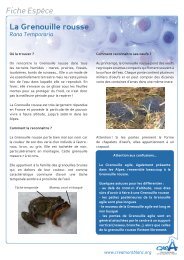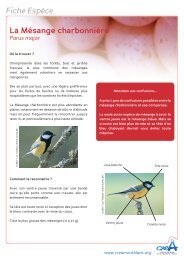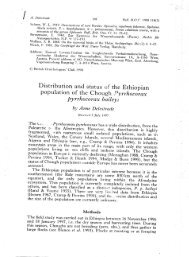European Journal of Forest Research. - CREA
European Journal of Forest Research. - CREA
European Journal of Forest Research. - CREA
Create successful ePaper yourself
Turn your PDF publications into a flip-book with our unique Google optimized e-Paper software.
Eur J <strong>Forest</strong> Res<br />
2005; Wipf 2010). This constraint may result in some highaltitude<br />
species lacking a response to higher temperature or<br />
earlier snowmelt (e.g., Ranunculus glacialis, Totland and<br />
Alatalo 2002), which may make them sensitive to invasion<br />
by more plastic species.<br />
In mountain regions, phenology and growth <strong>of</strong> tree species<br />
are strongly related to altitude-dependent weather conditions<br />
(e.g., for beech (Fagus sylvatica), see Dittmar and<br />
Elling 1999, 2006). However, few studies have focused on<br />
the effect <strong>of</strong> altitude on phenological events besides the<br />
obvious delay due to decreasing temperature with increasing<br />
altitude (Defila and Clot 2001, 2005; Dittmar and Elling<br />
2006;Rötzer et al. 2004; Vitasse et al. 2009a, b; Ziello et al.<br />
2009). Climate projections show that the Alps are expected<br />
to see a large increase in temperature in the next decades,<br />
particularly so in the summer (e.g., Beniston (2006) gave<br />
changes <strong>of</strong> summer temperatures by 2100 <strong>of</strong> 5.5–6 °C for<br />
the A2 scenario, with associated large changes in snow<br />
duration). Studies which have analysed phenological data<br />
from alpine areas (Theurillat and Schlüssel 2000; Defila and<br />
Clot 2001, 2005; Inouye et al. 2003; Keller et al. 2005;<br />
Huelber et al. 2006; Vitasse et al. 2009a, b; Ziello et al. 2009)<br />
have mostly ignored topographic variables beside altitude,<br />
such as exposure and slope which may also influence the<br />
appearance <strong>of</strong> phenological events besides the direct effect<br />
<strong>of</strong> temperature changes (e.g., Jackson 1966).<br />
In this study, we analysed how air temperatures, altitude<br />
and other topographic variables affected species-specific<br />
phenological responses. We focused on two spring events,<br />
budburst and leaf unfolding which are known to be<br />
strongly determined by temperature, in order to exemplify<br />
the spatial variation in the relationship between temperature<br />
and phenological events. We focused first on comparing<br />
altitudinal gradients in spring event dates among<br />
species and years. We then tested if the impact <strong>of</strong> air<br />
temperature, measured using thermal sum was independent<br />
<strong>of</strong> altitude. We used data from a volunteer-based research<br />
project, ‘‘Phénoclim’’ which aims on the long-term at<br />
determining the effect <strong>of</strong> the climatic changes on plant<br />
phenology in the Alps. This programme takes place in the<br />
entire French Alps and relies upon the public participation<br />
for the monitoring <strong>of</strong> the phenological events.<br />
Materials and methods<br />
We used the initial 2-year period <strong>of</strong> the ‘‘Phénoclim’’ project,<br />
2006 and 2007 based on phenological measurements made on<br />
tree/shrubs from 83 sites in the French Alps (Fig. 1). Thirtysix<br />
sites were equipped with meteorological stations, designed<br />
for the ‘‘Phénoclim’’ project. These stations measured air<br />
temperature at standard height (2 m) every 15 min with a<br />
DS18B20 Digital Thermometer (Dallas Semiconductor<br />
MAXIM, www.maxim-ic.com), with an operating range <strong>of</strong><br />
-55 to 125 °C and an accuracy <strong>of</strong> ±0.5 °C over the range <strong>of</strong><br />
-10 to 85 °C. The stations are supplied with four batteries<br />
LR20 1.5 V. The temperatures recorded by these stations<br />
were highly correlated with standard temperatures obtained<br />
from national meteorological stations (e.g., at Chamonix:<br />
correlation coefficients = 0.97, 0.95 and 0.97, respectively,<br />
for minimum temperature, maximum temperature and mean<br />
temperature; data from Chamonix station obtained from<br />
Meteo France). We used the data from ‘‘Phénoclim’’ stations<br />
to calculate the daily mean temperatures as the national<br />
meteorological stations were too sparse in the study area.<br />
For each phenological site, we used the following predictor<br />
variables in the statistical models: geographic<br />
coordinates (latitude and longitude in Lambert II extended<br />
projection), altitude, curvature (measured by the second<br />
derivative <strong>of</strong> altitude measured over neighbouring pixels<br />
(ArcGIS 2004); negative if concave and positive if convex),<br />
the slope (in degrees) and the exposure (measuring<br />
southness: N = 0; NE = NW = 0.75; E = W = 0.5,<br />
SW = SE = 0.75, S = 1) (Table 1). The altitude <strong>of</strong> the<br />
meteorological stations ranged from 245 to 1,921 m and<br />
that <strong>of</strong> the phenological sites was 240 to 2,136 m. Since all<br />
the phenological sites were not equipped with meteorological<br />
stations, we interpolated temperature on these sites<br />
from temperature data <strong>of</strong> sites with meteorological stations<br />
(see statistical modelling).<br />
Phenology <strong>of</strong> budburst and leaf unfolding was studied in<br />
five shrub/tree species: two broad-leaved trees, birch<br />
(Betula pendula) and ash (Fraxinus excelsior); one shrub,<br />
hazel (Corylus avellana); and two coniferous trees, spruce<br />
(Picea abies) and larch (Larix decidua).<br />
In the present study, budburst was defined as the first day<br />
the first leaf-stalk <strong>of</strong> the plant was visible. Leaf unfolding<br />
was defined as the first day a leaf was unfolded so the petiole<br />
could be seen. At each site, phenological events <strong>of</strong> three<br />
individuals per species were observed. Phenological observations<br />
were recorded weekly. The three individuals were<br />
chosen to be in the same topographic conditions and close to<br />
each other (between 5 and 500 m). Furthermore, as the age<br />
and height <strong>of</strong> a tree may influence its phenology, we used<br />
data from adult individuals with a minimum height <strong>of</strong> 7 m for<br />
trees and 3 m for shrubs. As species were not found at all<br />
sites, the design is unbalanced.<br />
Many studies have shown that the timing <strong>of</strong> the spring<br />
phenological events is mainly induced by temperature<br />
(Defila 1991; Fitter et al. 1995; Sparks et al. 2000;<br />
Chmielewski and Rötzer 2002; Gormsen et al. 2005;<br />
Menzel et al. 2008). Most analyses so far have focused on<br />
temporal variations in timing <strong>of</strong> phenological events, but in<br />
this study, we focused on understanding the spatial variation,<br />
in particular, with respect to altitude and other topographic<br />
factors. If the effect <strong>of</strong> temperature was identical at<br />
123



![[pdf] Fiche Relais Phénoclim - CREA](https://img.yumpu.com/51248032/1/184x260/pdf-fiche-relais-phacnoclim-crea.jpg?quality=85)






